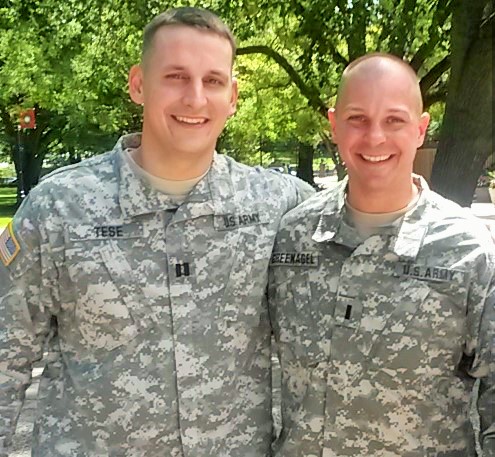When I was 19 years old, I signed an eight year contract with the United States Army. I went to basic and advanced training at Ft. Knox, KY and studied to be a tanker on the M1A1 Abrams Tank. I was our platoon leader throughout basic and earned an Excellence in Armor award. I eventually went home and served in the NJ National Guard. I drilled at Ft. Knox, Ft. Drum and Ft. Dix. In 1999, I received the Army Achievement Award. In 2001, my unit was activated a few weeks after 9/11 and we were sent to guard the Hudson River crossings (Holland, Lincoln, Path and the GW) during a time of great national mourning and anxiety. Afterwards, I desired to travel abroad and get further schooling, and I was granted my Honorable Discharge in 2004.
There were a few individuals I really liked (Drill SSG Moses, Drill SFC McCottrell, MSG Spadoni, SGT Geleta, Cadet Tese, Major Manfre) and a number that I was less enthusiastic about. There were good things and bad things about the military. I felt a great sense of pride in serving in the same branch as Washington, Grant, Sherman, Roosevelt, Eisenhower, Patton and Robinson. I enjoyed wearing the uniform, but wasn’t thrilled about shaving or shining my boots (my other likes and dislikes are unimportant and best kept to myself).
The Army served me well. I know that it made me more organized and more adaptable, and people that interviewed me tended to value it. I used my GI Bill to pay for part of my undergraduate degree and I bought a house with a VA Loan. When I became a therapist, I found that veterans usually felt comfortable speaking to me. During my five years at Rutgers CAPS and the Rutgers Newark Counseling Center, I worked with a decent amount of veterans. I enjoyed talking with them, encouraging them and helping them in whatever ways I could.
———-
One of my students at Rutgers was a Marine who served in the Middle East. While over there, he experienced a great deal of trauma. He had trouble sleeping and was diagnosed with PTSD. The unit doctor prescribed him with Xanax and Oxycotin. He was able to sleep better and return to the field, for a time. Eventually, he became addicted and was discharged under other than honorable conditions (those with an other than honorable discharge are usually denied various VA benefits). My student returned to NJ and quickly moved on from pills to heroin. He ended up on the streets of Paterson. He almost died. He went to some NA meetings and eventually got clean. He returned to work and became an electrician. After doing that for a few years, he decided to go back to college. He went to a community college and graduated with a 4.0. Last fall, at seven years clean and sober, he transferred to Rutgers to further his education. A few days before he was supposed to move in, he decided that he did not want to live with three 18 year olds whose notion of college probably differed from his. He made the decision to commute from Paterson each day. That commute took 80 minutes each way; by mid-October, it had taken its toll. The Marine contacted the Rutgers Veterans’ House and spoke with Col. Stephen Abel who sent him to me. He told me his story and that he was looking for a safe place to live on campus. Normally, I would interview students two to four times and spend 30 to 60 minutes with them each time before deciding whether or not to accept them into the Rutgers Recovery House. Ten minutes into his story, I told him “to shut up and get your things. You can move in immediately.”
He moved in within the next couple of days and the other students, despite being, on average, over a decade younger than him, took to him. He was a likeable role model. In December, I had him speak before the Governor’s Council on Alcoholism and Drug Abuse. After he told his story, Council members asked him a number of questions. He told them that his story was common and that many of his fellow Marines were discharged under similar circumstances. He described sub-par treatment and non-existent therapy. The Council was aghast.
Over the next few days, I called a number of Army bases and talked to a variety of commanders and medical officers. I offered up my services as a national expert on addiction and recovery issues and told them that I was an Army veteran. I was told that the Army almost never employed outside trainers. I called my friend and college roommate, Captain Gabriel Tese, an Army lawyer currently serving at Ft. Hood, Texas. He told me that my student’s story was common and that a majority of the cases he prosecuted involved soldiers with substance abuse problems, and that prescription drug abuse was a massive issue. Eventually, I talked to an active duty Colonel who said, “How old are you son?”
I told him that I knew where his question was leading and that I wasn’t interested.
“You are interested. This is an issue that you care about and that you are able to do something about. If you are as good as you say you are, you can make a real difference. The Army will be good to you and for you.”
I thanked him and hung up the phone. Two days later, I went down the rabbit hole and read about the Army Medical Corps and the position of Behavioral Science Officer.
———-
Back in May, I wrote about how America Fails Its Veterans. America also fails her active military personnel: those with PTSD, traumatic brain injuries, prescription drug addictions, alcohol dependence or other problems are often given sub-standard care. In 2007, the scandal at Walter Reed Hospital dominated the news for more than a few cycles and it seemed that America might turn the corner on how it treated members of the Armed forces. Then we saw this VA scandal in 2009 and this one in 2014. Despite aggressively wearing flag pins and sending troops into war zones, the Republican party (again) voted down benefits for military personnel and veterans in 2014. Soldiers and veterans are ubiquitous at professional sporting events, and the crowds always stand and cheer for them when they walk onto the field or appear on the jumbo tron. That tends to be the extent of the support they get from the public, aside for some Facebook appreciation and hashtag activism. People need to do more than say “thank you for your service,” cheer for veterans during sporting events or share a meme on Facebook (I don’t want to minimize these things though. They are helpful gestures and are appreciated. We just need to do more). We need them to tell their Congressman to vote for more military and veterans benefits, like basic, timely medical service.
The aforementioned Colonel told me that the military also needs highly trained professionals to give of themselves and their unique abilities. They need doctors, nurses, social workers, psychologists and members of the clergy to support the troops.
I have my hands in many things, a lot of work obligations and a large number of hobbies that I like to partake in. I’ve already served in the military. I can make more money doing other things.
If not me, than who? If not now, then when?
———-
On August 29, 2014, I rejoined the United States Army as a First Lieutenant. My old friend, college roommate and fellow guardsman, Captain Gabe Tese swore me in. The brief ceremony was performed on the Rutgers campus next to the WWII and Vietnam memorials. My Dad, wife and a few friends bore witness. Most significantly, that Rutgers Marine who caused all of this was there too.
I will serve as a Behavioral Science Officer in the Pennsylvania National Guard. Of course, I will help whomever I can that suffers from PTSD and/or substance abuse problems. But I also plan on helping soldiers with other aspects of their lives and encouraging those of all ages to go to college, whether it is veteran friendly schools like Rutgers or somewhere else.
I’ve thrown my hat back in the ring. I hope others will follow.







